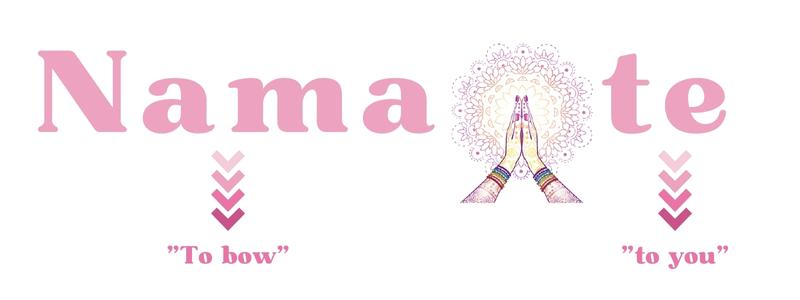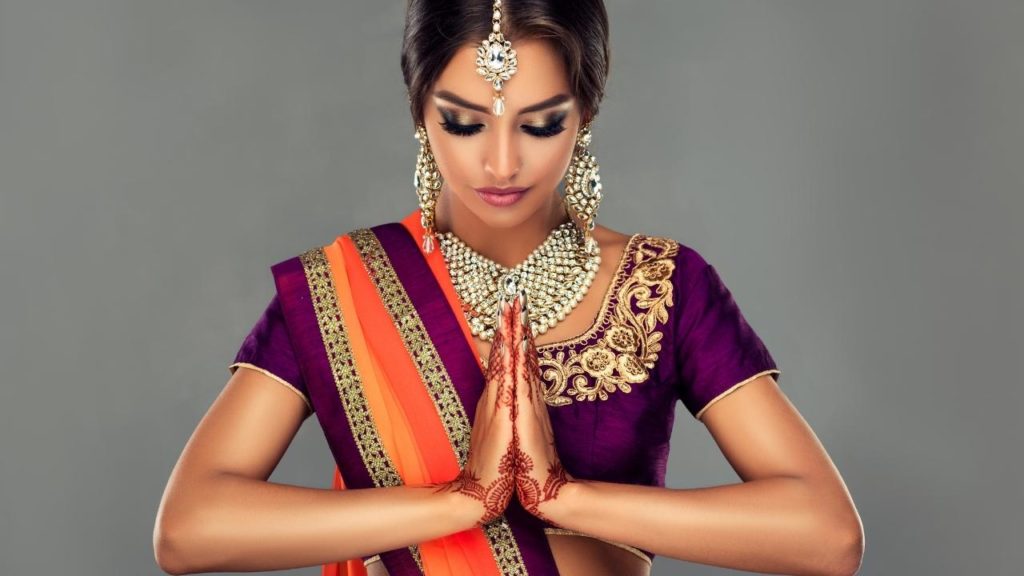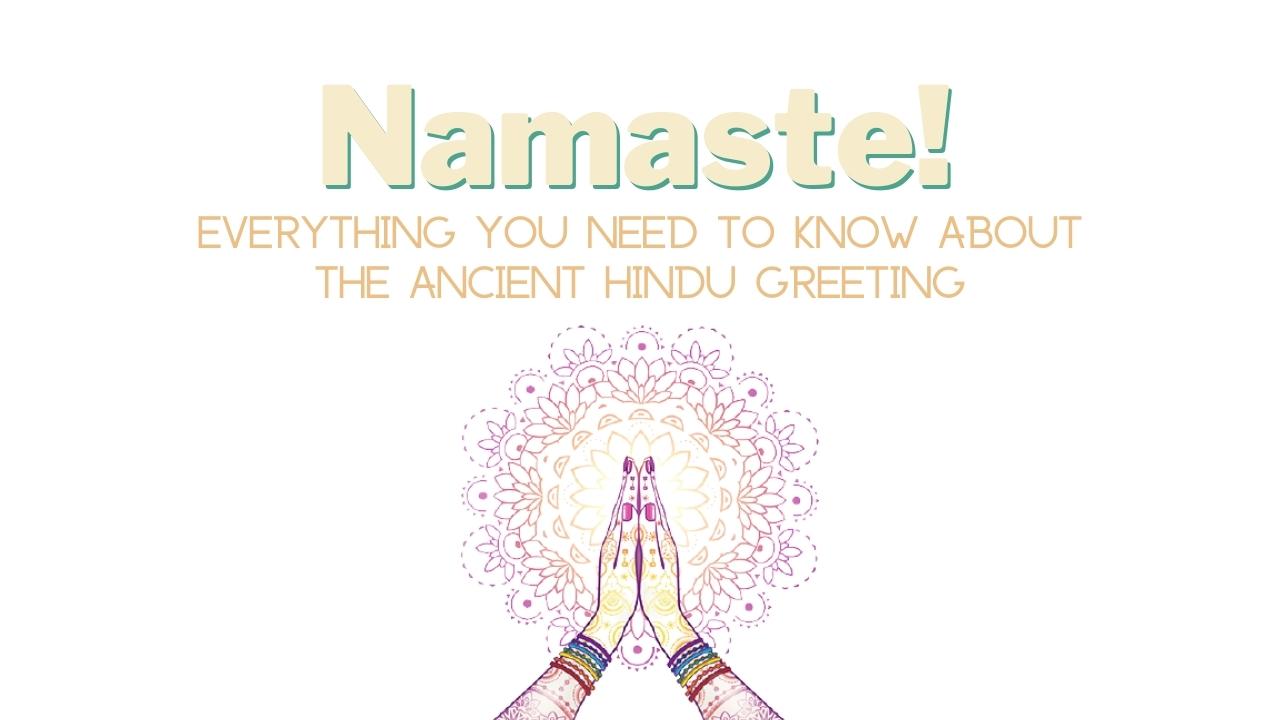What does Namaste mean? How is Namaste used in Yoga practice, and how is it pronounced? When should you use Namaste, and when shouldn’t you? In this article, we cover everything you need to know!
Table of Contents
- The History
- What does it mean to say Namaste?
- When to use it
- When not to use it
- Deeper Meaning
- Is Namaste a polite word?
- What is the reply to Namaste?
- Is Namaste a Mudra?
- How do you pronounce it?
- What’s the difference between Namaste and Namaskar?
- How to use Namaste in Yoga
- Summary
If you have been practicing Yoga for any length of time, chances are that you came across the Hindu greeting of Namaste. In western Yoga classes, Namaste is most often used as a closing word for a Yoga session, not so much as a form of greeting.
Many of our students asked us the question: what does Namaste mean? This common question got us thinking, and we decided to dive deeper into the true meaning of the word.
The History
The roots of the word Namaste date back to ancient times in Hindu culture.
To our knowledge, the first evidence of the word or gesture of Namaste in combination with Anjali Mudra has been found in excavations in the Indus Valley Civilisation between 2000 BC and 3000 BC in the form of an ancient piece of stone artwork showing a woman holding her hands together in Anjali Mudra with the expression of a greeting.
What does it mean to say Namaste?
The meaning of Namaste is more than just a word. It is a gesture that signifies respect and can be used as both a “hello” and a “goodbye.” There is a lot of deeper meaning attached to the word, but when translated from Sanskrit, Namaste literally means “I bow to you” or “To bow to you.”

Namaste is often used as a form of greeting, but it can also be used as a way to thank someone or express appreciation. It is common to see Namaste used in Yoga classes as a sign of respect between the teacher and the students.
The meaning in Hindu culture is probably deeper and different than here in the western world, where most people simply see it as a greeting or something you say before or after a Yoga class.
When to use it
Now that we know the meaning of Namaste, when is the appropriate time to use it?
The answer is quite simple – use it whenever you feel like it! There are no hard and fast rules about when to use Namaste. However, here are a few general guidelines:
- If you are greeting someone, you can say it as a way to say “hello.”
- If you are thanking someone, you can say it as a way to say “thank you.”
- If you are expressing appreciation, you can say it as a way to show your appreciation.
- You can use it at the beginning of a Yoga class.
- You can use it to greet your Yoga teacher and fellow students and show your respect.
- You can use it at the closing of a Yoga class after the teacher says it.
When not to use it
Now that we know when to use Namaste, when shouldn’t you use it?
Again, there are no hard and fast rules about this. However, here are a few general guidelines:
- Don’t use it if you don’t feel like it. Only use it if you truly mean it.
- Don’t use it if you are feeling angry or upset. Namaste is a gesture of peace and respect, so it is best used when you are feeling calm and positive.
- Don’t use any disrespectful derivations of the word, such as “Namaslay” or others.
- Don’t use it as a joke or to mock someone.
Also, don’t use any of the phrases out there that have somehow got into mainstream Yoga in recent years. People walking around with T-Shirts with “Namaste, Bi****s” printed on it or other derivations of the word such as “Nama’stay in bed” or “Namaslay” are inappropriate and disrespectful uses of the word and should be avoided.
Not only isn’t this cool, but it can also cause distress in other Yoga practitioners that take their practice seriously, potentially getting you in trouble or even dismissed from your Yoga studio or Yoga class.
We highly encourage you to only use the word with its true meaning attached to it and with pure intention since Namaste is a beautiful word with a lot of meaning behind it.
Deeper Meaning
While the widely used Namaste meaning is often referred to as “To bow to you” or “I bow to you,” there is a deeper meaning attached to the word. If we take the word apart, the literal translation is:
- Nama – “bow”
- te – “to you”
As you can see, the letter “s” isn’t directly mentioned, but it sometimes is translated as “I.” So putting it all together, we can confidently say Namaste means “I bow to you.” While this is the direct meaning, there is a deeper meaning. Namaste also can be translated or interpreted as “I bow to you to your soul to the divinity within you.”
There is also a Namaste Prayer, which is a beautiful representation of the deeper meaning of the word:
“I honor the place in you in which the entire universe resides.”
– Namaste Prayer
“I honor the place in you which is of light, of truth, love, and peace.”
“When you are in that place in you, and I am in that place in me, we are one.”
Is Namaste a polite word?
Yes, Namaste is a polite form of saying “hello” or “goodbye” in Hindu culture. While not exclusively being used for the former, Namaste can also be used to express a polite way of saying “thank you” or showing gratitude.
Often the word is used to greet a person of authority or someone you respect, as well as to a dear friend or family member.
What is the reply to Namaste?
There is no specific reply to Namaste. A simple “thank you” or “Namaste” is often used in return as a sign of appreciation or respect.
If someone is approaching you with a friendly Namaste, holding his or her hands in Anjali Mudra (prayer position), you can politely reply with “Namaste” while also holding your hands in Anjali Mudra and bowing your head ever so slightly. This will be met by great respect from the opposite party and it will be appreciated as a friendly gesture.
Is Namaste a Mudra?
No. Namaste is not a Mudra in and of itself. But we do use a Mudra while saying it: Anjali Mudra.

Anjali Mudra is a Mudra (hand gesture) that is often used during meditation or in prayer. It is done by pressing your palms together in front of your heart and bowing your head.
This Mudra symbolizes reverence, honor, and respect and can be used as both a greeting and a way to show appreciation. Namaste is often done with Anjali Mudra as a way to show respect to the person you are greeting.
Joining the hands together in Anjali Mudra is not only a sign of respect, but it is also a call to align your energies by joining your hands together. The Mudra also represents the coming together of masculine and feminine energy, as well as the union of mind, body, and spirit.
How do you pronounce it?
The correct way to pronounce Namaste is “Nah-mah-stay.” However, it is often mispronounced as “na-ma-stei” or “na-ma-stey.” If you are unsure of how to say it, the best way to learn is by listening to someone else say it first.
While it is not impolite or rude to pronounce it wrong, it should be something you practice if you use the word regularly. Usually, the best way to practice is by watching videos on YouTube or by asking your Yoga teacher.
Experienced Yoga teachers can usually teach you the correct pronunciation of the word so that you can greet your fellow students or teachers with confidence!
What’s the difference between Namaste and Namaskar?
Namaskar and Namaste are often used interchangeably, but there is a difference in their meanings.
Both words are derived from the Sanskrit root word “Namah,” which means “to bow” or “salutation.” However, Namaskar is a compound of two words: “Nama” and “Skar.” So, Namaskar can also be translated as “I salute to you,” but it also means “I salute to you in your (yoga) posture.”
Namaskar is often used as a greeting, much like Namaste, but according to some of our Hindu friends, it is more widely used to greet a larger group of people or when greeting someone of authority or significance, both spiritually and generally.
A good example of this would be “Surya Namaskar,” more commonly known as Sun Salutation, a term most Yoga students are familiar with, where the direct translation is:
- Surya – “Sun”
- Namaskar – “Salutation”
We think it is safe to translate it as “I salute to you.”
Namaste, on the other hand, is a standalone word that can be used both as a greeting and as a way to show appreciation. It can be used in any situation, not just in Yoga class. So, while both words have the same root meaning, Namaskar is more specific to yoga practice, while Namaste can be used in any situation.
How to use Namaste in Yoga
There are many ways you can use Namaste in your Yoga practice.
- As a greeting: When you first come into class, you can greet your teacher and fellow students with Namaste. This is a great way to start the class on a positive note and set the tone for the rest of the practice.
- As a way to show appreciation: At the end of class, you can use Namaste as a way to thank your teacher for their time and effort. You can also use Namaste to show appreciation for your fellow students or even yourself!
- As a way to align energies: During your practice, if you feel like you need to center yourself or align your energies, you can take a moment to do Namaste. This can be done with or without Anjali Mudra.
- As a way to end your practice: When you are finished with your practice, you can use Namaste as a way to close the class. This is a nice way to end on a positive note and leave the class feeling good.
- As a way to close your class as a teacher: If you are a Yoga teacher, closing the class with Namaste can be a great way to end the practice while showing respect to your students. This ends the practice with gratitude and in a peaceful way.
Namaste can be used in any way that feels right for you. There is no wrong way to use it!
Summary
After reading this article, there should not be anymore misconceptions about how to use Namaste and when to use it. You don’t need to be afraid to reply with a friendly “Namaste” when your Yoga teacher is closing the class, or when someone greets you using the phrase.
It is a beautiful word that holds deep meaning for a lot of people. Here is a short summary of what you have learned in this article:
- Namaste is a word of Sanskrit origin that has many meanings, including “I bow to you,” “to honor the divine in you,” or simply “hello.”
- It is commonly used as a greeting in Yoga classes but can be used in other situations as well.
- Namaste can be used to show appreciation, align energies, or close a yoga class.
- There is no wrong way to use Namaste – use it in whatever way feels right for you!
